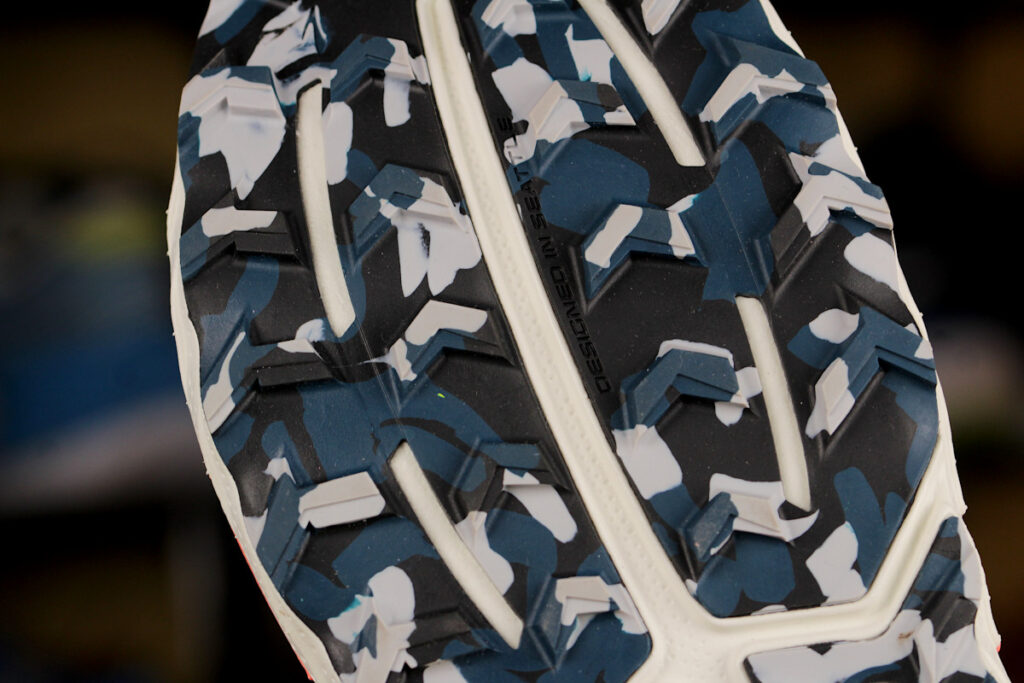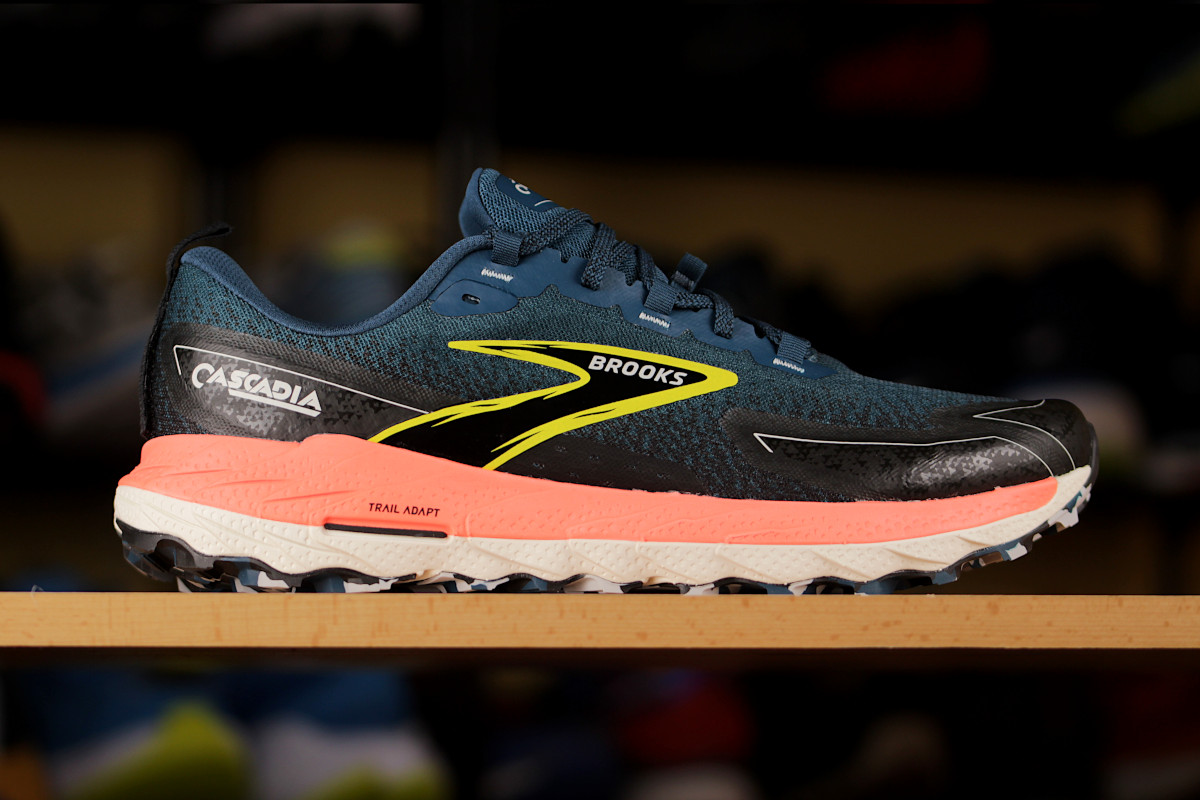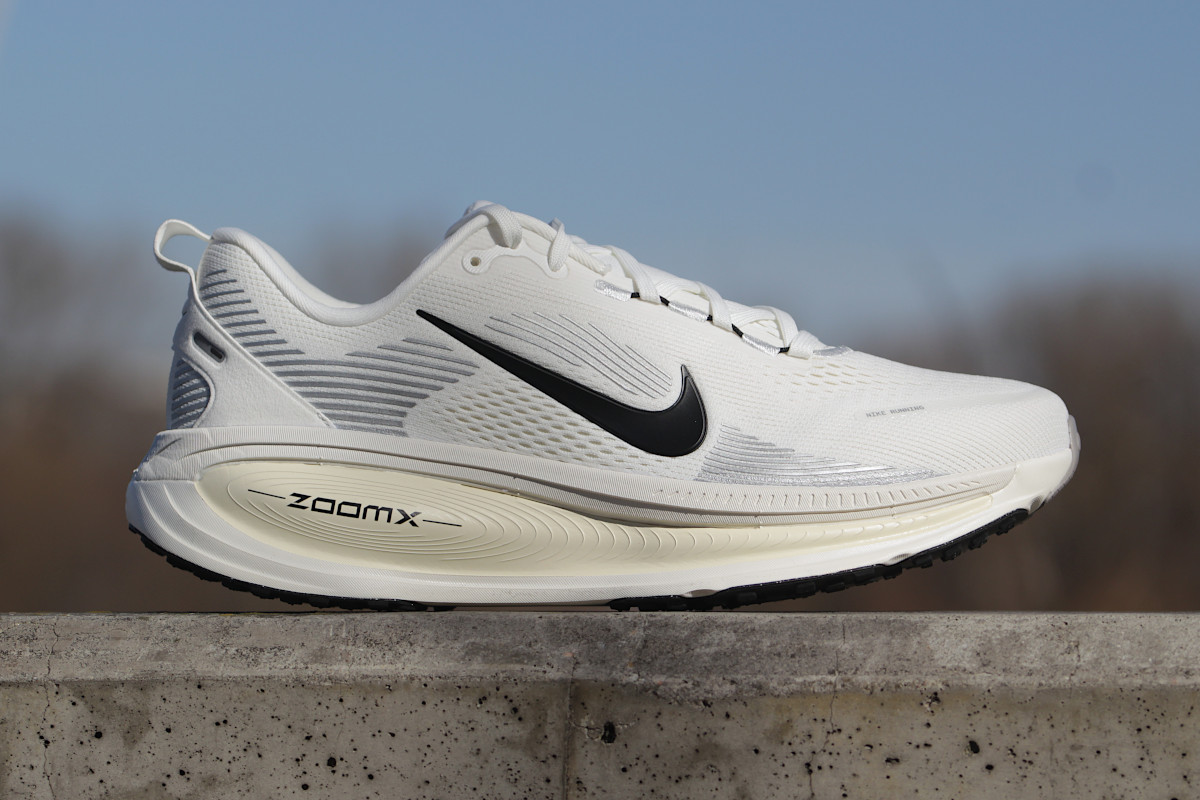The Cascadia 18 is the next iteration of Brooks’ iconic trail shoe, which has balanced cushioning and stability for years. This version features a modified Trail Adapt platform with independently functioning midsole elements designed to better adapt to different surfaces. It also features lightweight DNA Loft v2 foam, a fairly aggressive outsole, and a roomy upper that allows for a lot of freedom of movement. On paper, it looks like the perfect companion for running on difficult terrain. But how does it perform in the real world?
Basic info
Tech specs
Purpose
The Brooks Cascadia 18 is a solid choice for those looking for good cushioning and stability. Its balanced geometry and construction make it perfect for technical mountain trails, even ultra-distances. But its greatest asset is its versatility – the Cascadia is not afraid of rocky descents, but it also performs well on soft forest trails or less demanding training routes. It is a universal trail shoe that can successfully serve as your main trail shoe, whether you are hiking hundreds of miles in the mountains or just running in the nearby woods every day.

Pros
- lots of cushioning,
- very good stability,
- good stone protection,
- spacious interior, suitable for wider feet,
- high outsole for a universal all-terrain boot,
- comfortable heel – soft but firmly supportive,
Cons
- no “rocker” and general “flatness” – you won’t find any dynamics here
Brooks running shoes – what’s in the lineup?
The Brooks trail lineup is not overly extensive, but it is well thought out. The brand focuses mainly on three key models – and it just so happens that each of these starts with the letter “C”:
- Cascadia is the most versatile of the three – balanced for medium and long distances, with an emphasis on stability and predictability in difficult terrain.
- Caldera goes in a completely different direction – maximum cushioning, ideal for ultra runs, where comfort for many hours is what counts.
- Catamount is the option for those who are looking for lightness and responsiveness – a dynamic midsole, low weight, and a lot of terrain feel.
You can find a complete shoe guide for Brooks trail shoes in our model overview.
| TRAIL | MIXED TERRAIN | |
|---|---|---|
| long, easy runs |  Caldera 8 | |
| versatile |  Cascadia 18 |  Divide 4 |
| light and dynamic |  Catamount 4 |
Brooks Cascadia 18 alternatives
The Cascadia 18 is more of an evolution than a revolution from its predecessor-the changes are cosmetic and its role in the Brooks lineup remains unchanged. It is still a general purpose trail shoe with good cushioning and solid stability. The alternatives on the market have not changed either – it is still one of the most densely populated segments where it is not difficult to find something for yourself. What do these shoes have in common? First and foremost, they have balanced cushioning (not extreme, but sufficient for long runs) and versatility. Models like the Cascadia are great for technical mountain trails as well as everyday runs on forest trails or gravel roads.
| MODEL | STACK HEIGHT (mm) | DROP (mm) | WEIGHT MEN'S (grams) | WEIGHT WOMEN'S (grams) | REGULAR PRICE (€) |
|---|---|---|---|---|---|
| Asics Gel-Trabuco 13 | 35,5/27,5 | 8 | 285 | 250 | 160 |
| Brooks Cascadia 18 | 33/25 | 8 | 314 | 286 | 150 |
| Mizuno Wave Daichi 7 | 33/25 | 8 | 308 | 255 | 150 |
| New Balance Hierro v7 | n/a | 8 | 301 | 235 | 160 |
| Nike Wildhorse 8 | 35/27 | 8 | 300 | n/a | 130 |
| Salomon Genesis | 34/26 | 8 | 269 | 242 | 160 |
| Salomon Sense Ride 5 | 29/21 | 8 | 293 | 247 | 130 |
Cushioning: soft yet sturdy
Like its predecessor, the Cascadia 18 features the Trail Adapt System, a three-piece midsole construction that balances cushioning, protection and traction. The whole thing is built around three key components: DNA Loft v2 foam, Ballistic Rock Plate and TrailTack rubber outsole. It’s a classic 3-in-1 designed for a variety of terrain.

The midsole is still based on the well-known DNA Loft v2 foam – the same that Brooks used in the previous version. According to the manufacturer, there is 33 mm of foam under the heel and 25 mm under the toes, which results in a drop of 8 mm. This is a symbolic increase of 1 mm compared to the Cascadia 17, but in practice it is hardly noticeable underfoot. Cushioning is solid – sufficient for long runs, but without the “cushioning” effect. Compared to maximalist models like the Caldera, the Cascadia is much more compact and resilient. Comfort is there, but it is not lazy – it is a good balance between protection and stability, which translates into confidence on variable terrain and longer distances, even at the ultra limit.
The Cascadia 18 is a shoe that does not stand out for its dynamic features. Although it offers good cushioning, it lacks elements that would accelerate forward movement. For example, there is no rocker, which is a molded midsole that provides a smooth roll from heel to toe. As a result, the shoe is fairly “flat” on the run – it doesn’t have the energetic bounce of some competing models. Instead, the Cascadia focuses on versatility and reliability, making it a true trail workhorse-a safe, stable choice for long miles where comfort and control, not speed, are the priority.

Ballistic Rock Shield for protection against stones
The second key element of the TrailAdapt system is the BRS, or Ballistic Rock Shield. In version 18, as in previous editions, its role is to distribute point pressure over a larger surface area, significantly improving comfort when running on difficult, rocky terrain. Thanks to this technology, stones do not dig directly into the foot and their presence on the track is less noticeable. In addition, the stiffness of this plate combined with the soft DNA Loft v2 foam gives the entire construction greater stability. There is a lot of stability in this shoe.

An outsole that grips everything
The outsole of the Cascadia 18 is unchanged from the previous edition. It retains its characteristic aggressiveness and versatility. This allows the shoe to handle more challenging mountain conditions as well as less demanding trails such as suburban woods or parks. The outsole studs are quite high – they are 3.8mm high, which means better “bite” into the surface. The studs are arranged in a typical trail running pattern, with the front studs pointing backwards for better grip on uphills and the rear studs pointing forwards for better stability on downhills. The Trail Track Rubber completes the package, providing solid grip on a variety of surfaces and giving you a sense of durability and confidence in the Cascadia.

Upper: more freedom of movement, more protection
The upper of the Cascadia 18 is also a familiar construction from the previous model. It is made of a fairly thick technical double-layered mesh. The front part is secured with a solid reinforcement – a large “bumper” that protects the toes from unexpected impacts. The reinforcement flows smoothly into the cuff, which also protects the front of the shoe from damage. Despite the lack of reinforcements in the upper and the fact that the entire front of the shoe is a smooth mesh surface, ventilation is not outstanding. Breathability is fairly moderate, which works well on colder days. However, it can be too hot on very warm days.
However, the shoe offers plenty of room. The width of the upper at the widest point is 105.8 millimeters, which puts it in the group of shoes with a slightly wider upper. The same goes for the interior – there is plenty of room, and with the right shoe size, there is also plenty of room around the toes. The Cascadia 18 is a wide shoe that will suit people who are looking for space, especially runners with a lower instep. This amount of space is also a great solution for ultra running, where the foot can swell over long distances.

The upper also has some interesting details that make life in the field more comfortable. First of all, there is a tongue integrated into the upper. This solution effectively limits its movement to the sides and at the same time helps to keep mud and small debris out of the shoe. Between the laces, just above the tongue, there is a flexible loop where you can hide the ends of the laces – no more flying tails. And to top it all off, there is a Velcro closure on the heel counter that is theoretically used to attach gaiters. Practically no one uses it because most gaiters are attached in some other way anyway. But it’s nice that it’s there – maybe it will come in handy someday.
As you would expect from a very stable shoe around the heel, it is also very stable. Inside the upper, there is the typical solid stiffening that not only makes the shoe stable, but also keeps the foot in the right position. In addition, soft sponge padding effectively envelops the foot. So the back of the shoe combines the features that have been in the DNA of this model for years – softness and stability. So you won’t need it on demanding terrain.

Balance: the golden mean of a trail
According to the manufacturer, the Brooks Cascadia 18 weighs 314 grams for men and 286 grams for women, which is in the standard range for trail running shoes. This is similar to the weight of the previous model, so you could say that nothing has changed. However, when I measured the weight of my size 12 US (46), it was 359g – 24g less than the previous edition. Why the difference? I don’t know exactly. However, this weight is exactly what you want in a trail shoe – not too heavy, not too light. Just right for comfort and stability without weighing you down.

Summary
The Brooks Cascadia 18 is a rugged trail shoe for those looking for proven stability, good cushioning and traction on a variety of trails. It is equally at home in the mountains as it is on everyday forest trails. The upper offers protection and space, and the heel provides a secure fit and comfort. The boot may not be dynamic, but it makes up for it with its versatility and balanced construction. It is not a revolution, but rather a refined evolution – still reliable and ready for long miles on the trail.




